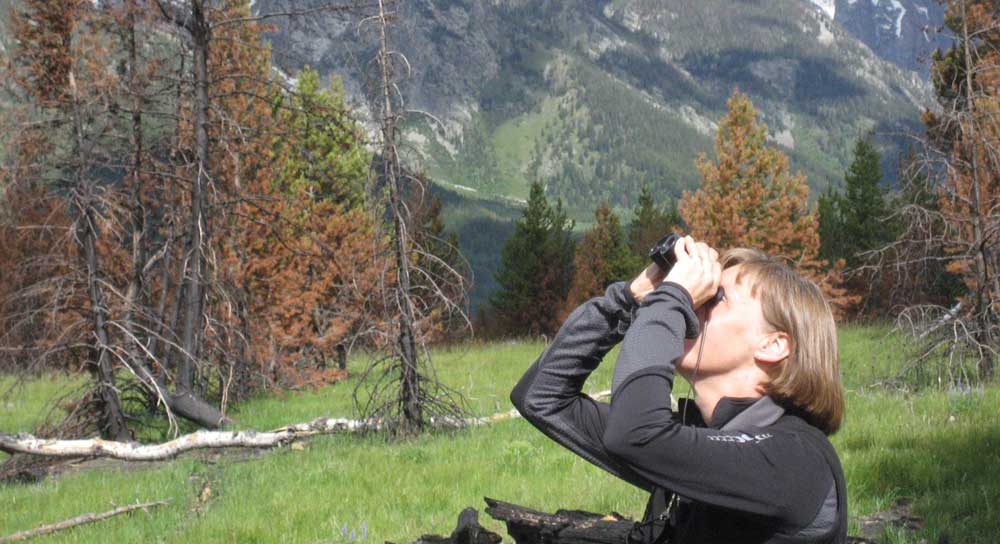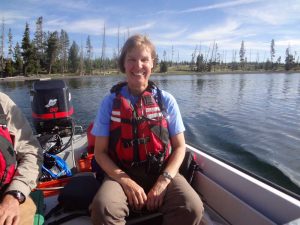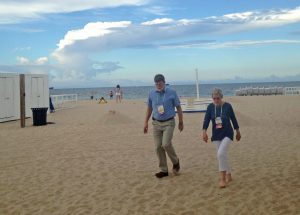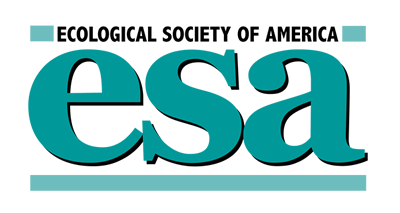
Executive Letters
Letter from the President

Landscape ecologist Monica Turner, ESA president, travels in her team’s boat, PICO1, across Yellowstone Lake in Yellowstone National Park in July 2012 to access long-term study plots in areas that burned during the 1988 Yellowstone Fires. Named for Pinus contorta, the lodgepole pines that dominate Yellowstone’s forests, PICO1 gets Turner and her group to remote study areas that are more easily reached from the lakeshore. The July trip was part of a major resampling of long-term plots 25 years after the 1988 fires. Turner took over the presidency of the Ecological Society of America in August 2015 and will serve one year. Credit, Monica Turner.
After the Ecological Society of America (ESA) celebrated its 100th anniversary in Baltimore, it was my honor to serve as ESA president during the first year of our second century. As I reflected on the centennial milestone and anticipated the year ahead, I was struck by the magnitude of the changes affecting ecology and ecologists; my thoughts were conveyed in an editorial in the August 2015 issue of Frontiers in Ecology and the Environment. Now, as I look back on the past year, I am pleased to see us embracing the future ahead.
Last year was momentous for ESA in several ways. Among the most prominent activities was the successful transition of our publications from the self-publishing mode that served us well for many years to a new seven-year partnership between ESA and Wiley. The many benefits of this partnership include more stable Society finances, free online access to all ESA publications for each of our members, use of state-of-the-art publishing technology, and increased financial support for ESA awards programs. Of course, major transitions are always somewhat disruptive, and this was no exception. The hard work of the ESA staff, Wiley staff, and ESA Publications Committee, and the extra effort (and patience) required of all editors, authors, and reviewers as we progressed through the transition this past year is deeply appreciated. Our publications are excellent, and the trajectory is now decidedly positive.
Prompted in part by the opportunities afforded by the publications transition and the exponential increase in demands on scientists, a major initiative was to lead a strategic planning for ESA and act on that planning in a timely way. In a nutshell, how ESA supports ecology and ecologists must evolve as the landscape of science changes. Thus, during summer 2015, we began a yearlong process that built on efforts of previous presidents (especially Sunny Power in 2009 and Steward Pickett in 2011). The August 2015 Council Meeting included discussion of the values of ESA membership and ways to ensure that ESA remains vital to all members. The November 2015 Governing Board included in-depth follow-up discussions about how ESA could best position itself to serve members in the years ahead and led to planning for a one-day retreat to develop vision, goals, and strategy. Executive Director Katherine McCarter, President-elect David Lodge, and I led this Governing Board and Staff retreat in May 2016. Among many worthy goals, we identified enhancing ESA member services and communications as highest priorities for the coming 3-5 years. Included under this broad goal are development and implementation of a comprehensive communications strategy that will lead to a redesigned digital presence and more effective use of diverse and emerging channels; strengthening of programs for non-academic ecologists so that ESA better serves these members and supports professional preparation for a wider range of careers; and enhancement of the benefits to academic scientists across all career stages and throughout the entire year. Implementation is already underway, and I look forward to seeing results of these efforts emerge in the months ahead.
Serving as ESA president does demand a considerable amount of time and effort, but I found it very gratifying. Several dimensions of my year as president were highlights for me personally and professionally. First, the opportunity to work with and become better acquainted with the ESA staff and my colleagues on the Governing Board was tremendous. We meet and work together intensively during the year, and it is fun to get to know new colleagues personally and to expand my professional network. The commitment of our staff and volunteer leadership to the health of the Society and to the science of ecology was also inspiring, and it is especially reassuring during times of rapid change and high uncertainty. Second, participating in the SEEDS Leadership Meeting in April 2016 was a real treat. I have been familiar with SEEDS for years, but seeing the program in action, meeting the wonderful young adults who were exploring careers in ecology, and being an active participant were terrific experiences. Interacting with members of the Student Section and the Early Career Ecologist Sections was also a pleasure. I take great solace in knowing there are so many talented, energetic, committed ecologists coming up through the professional ranks. And finally, it was a real pleasure to represent the Society in a variety of venues.
Now that we have entered our 2nd century, I am pleased that ESA has a history of which to be proud and a future for which we are preparing. I thank you – the membership of ESA – for the opportunity to have served you as president. However, to continue to thrive, ESA needs you; member involvement is crucial for any society to remain vibrant, relevant, and rewarding. Thus, I conclude by asking you to renew your commitment to sustaining ESA’s tradition of excellence by getting involved, staying involved, and making a difference.
Gratefully,
![]()
Monica G. Turner
President, 2015-2016
Letter from the Executive Director
The year between ESA’s 100th annual meeting in Baltimore and our 101st meeting in Fort Lauderdale was a time of great change and a time to look forward.

ESA member Tim Scholwater and Katherine McCarter, ESA executive director, enjoying the 2016 Annual Meeting closing social that was held on the Fort Lauderdale beach.
The decision by the ESA Governing Board to end self-publishing ESA journals and transition production to John Wiley & Sons set in motion a very demanding schedule for ESA. All of our archives, information, and processes had to be transferred to Wiley, and new systems and ways of publishing our journals needed to be established. At the same time, ESA continued to produce its journals until Wiley took over the production in January 2016. We were fortunate that our committed publications staff worked diligently to produce our journals even as they prepared to close the Ithaca, New York publication office in November 2015. It was difficult to say good bye to the very dedicated production staff, many of whom had worked for ESA for a number of years. Five new positions for peer review specialists were created and filled with individuals who had held similar roles before the transfer.
In early January 2016, we welcomed Steve Sayre as our new director of publishing, based in the Washington, DC headquarters. Sayre not only supervises the peer review staff and coordinates with the editors in chief, but also serves as ESA’s liaison with its new publishing partner. As with any transition of this magnitude, there have been bumps along the way, but working closely with Wiley, we work through each challenge. We are confident that we have emerged with a stronger publication program that allows us to expand and enhance our publications while also providing new and exciting opportunities for ESA to pursue.
There are notable accomplishments from the new publication structure:
• Increased distribution of ESA journals worldwide
• Online access to ESA journals for all members
• Increased impact factors in 2016 for all ESA journals
• 40% growth for Ecosphere, which published 425 articles in 2016 making it ESA’s largest journal
• Edited articles posted in Early View that significantly shorten the time to publish
The dramatic change in the way we publish our journals is allowing us to focus on other needs and to assess the future directions for ESA. Spearheaded by President Monica Turner, the Governing Board and management staff undertook a strategic planning effort that resulted in a strong commitment to enhance member services and to develop a coordinated communication plan for the organization. A new position, membership manager, was created and became operational December 2016. We will review, strengthen, and expand member services, provide benefits and networking opportunities for ecologists who choose careers outside of academia, and increase the benefits for academic scientists at all career stages. In the coming year, ESA will also develop a comprehensive communications strategy that not only will benefit our members, but will raise the visibility of ESA with decision-makers in the private and public spheres.
While much of our attention was on ESA’s publishing program and plans for the future, this annual report also highlights many exciting and important activities undertaken in the areas of science, meetings, education, and public affairs.
ESA is in a strong position for the future. As we look ahead to a new administration in Washington, ESA will actively convey the importance of ecological science in dealing with the challenges that face our planet. We will engage our membership, focus our efforts, and together will continue to be a trusted source of ecological knowledge.

Katherine McCarter
Executive Director
